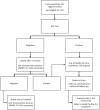Reaching transgender populations in Zambia for HIV prevention and linkage to treatment using community-based service delivery
- PMID: 36225155
- PMCID: PMC9557009
- DOI: 10.1002/jia2.25995
Reaching transgender populations in Zambia for HIV prevention and linkage to treatment using community-based service delivery
Abstract
Introduction: Transgender and gender-diverse communities in Zambia are highly vulnerable and experience healthcare differently than cisgender persons. The University of Maryland, Baltimore (UMB) supports projects in Zambia to improve HIV case-finding, linkage and antiretroviral treatment (ART) for Zambia's transgender community. We describe programme strategies and outcomes for HIV prevention, testing and ART linkage among transgender communities.
Methods: UMB utilizes a differentiated service delivery model whereby community health workers (CHWs) recruited from key populations (KPs) reach community members through a peer-to-peer approach, with the support of local transgender civil society organizations (CSOs) and community gatekeepers. Peer CHWs are trained and certified as HIV testers and psychosocial counsellors to offer counselling with HIV testing and prevention services in identified safe spaces. HIV-negative people at risk of HIV infection are offered pre-exposure prophylaxis (PrEP), while those who test positive for HIV are linked to ART services. CHWs collect data using the standardized facility and community tools and a dedicated DHIS2 database system. We conducted a descriptive analysis examining HIV testing and prevention outcomes using proportions and comparisons by time period and geographic strata.
Results: From October 2020 to June 2021, across Eastern, Lusaka, Western and Southern Provinces, 1860 transgender persons were reached with HIV prevention messages and services. Of these, 424 (23%) were tested for HIV and 78 (18%) tested positive. Of the 346 HIV-negative persons, 268 (78%) eligible transgender individuals were initiated on PrEP. ART linkage was 97%, with 76 out of the 78 transgender individuals living with HIV initiating treatment. Programme strategies that supported testing and linkage included peer CHWs, social network strategy testing, same-day ART initiation and local KP CSO support. Challenges included non-transgender-friendly environments, stigma and discrimination, the high transiency of the transgender community and the non-availability of transgender-specific health services, such as hormonal therapy.
Conclusions: Peer KP CHWs were able to reach many members of the transgender community, providing safe HIV testing, PrEP services and linkage to care. Focusing on community gatekeepers and CSOs to disburse health messages and employ welcoming strategies supported high linkage to both PrEP and ART for transgender people in Zambia.
Keywords: Africa; HIV care continuum; HIV prevention; community; differentiated care; transgender people.
© 2022 The Authors. Journal of the International AIDS Society published by John Wiley & Sons Ltd on behalf of the International AIDS Society.
Conflict of interest statement
The authors declare that they have no competing interests.
Figures



References
-
- UNAIDS . HIV and transgender and other gender‐diverse people — Human rights fact sheet series 2021. 2021. Available from: https://www.unaids.org/sites/default/files/media_asset/04‐hiv‐human‐righ.... Accessed June 14, 2022.
-
- Winter S, Diamond M, Green J, Karasic D, Reed T, Whittle S, et al. Transgender people: health at the margins of society. Lancet. 2016;388(10042):390–400. - PubMed
-
- Baral SD, Poteat T, Strömdahl S, Wirtz AL, Guadamuz TE, Beyrer C. Worldwide burden of HIV in transgender women: a systematic review and meta‐analysis. Lancet Infect Dis. 2013;13(3):214–22. - PubMed
-
- Operario D, Soma T, Underhill K. Sex work and HIV status among transgender women: systematic review and meta‐analysis. J Acquir Immune Defic Syndr. 2008;48(1):97–103. - PubMed
Publication types
MeSH terms
Substances
Grants and funding
LinkOut - more resources
Full Text Sources
Medical
Miscellaneous

